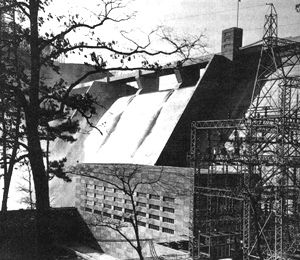
Norris Dam
Norris was the first Tennessee Valley Authority hydroelectric project, begun in October 1933 and finished in March 1936 on the Clinch River in Anderson County. It is a straight concrete gravity-type dam, 1860 feet long, 265 feet high, and 208 feet thick at the base, equipped with two 50,000-kilowatt generators located in a powerhouse on the right side of the dam face. The dam was named for Senator George Norris of Nebraska, a progressive Republican who for eleven years had kept alive a vision of public power in the Tennessee Valley and whose stubbornness finally bore fruit during the first one hundred days of the Roosevelt administration, when the TVA was created by an act of Congress. Total cost of construction, including acquisition of reservoir lands, was about $36 million.
The dam’s engineering predates the TVA, but its appearance owes everything to a young Hungarian-born architect, Roland Wank (1898-1970), the TVA’s first chief architect. The Bureau of Reclamation had drawn plans in 1927 for a dam at Cove Creek on the Clinch River that would increase the efficiency of the government-owned Wilson Dam at Muscle Shoals, Alabama, further downstream on the Tennessee River. When the TVA was created, it inherited both Wilson Dam and the site drawings for Cove Creek Dam (as Norris was then called), along with instructions from Congress to begin construction as soon as possible to relieve the appalling unemployment in the region.
Wank felt that the unimaginative and heavy appearance of the bureau’s design lacked the simplicity that should characterize TVA work, and he proposed a sculptural recasting of the dam’s elements, pulling the powerhouse and spillway face into a coherent composition. Applied ornament on the bureau’s scheme was replaced by sensitive massing, carefully proportioned window openings, and the subtle texture of concrete imparted by the formwork boards. Wank tried to make the dam look as functional as the engineers had designed it to be, even though the engineers were not pleased with his result. The distinguished industrial architect Albert Kahn was asked to choose between the original design and Wank’s proposal, and his vote for Wank’s scheme was subsequently upheld by the TVA Board, thus starting the TVA on a course of modern design that would characterize all the authority’s projects through the end of the 1950s.
Wank was concerned with more than external appearance, however. At his insistence, the landscaping and approach route to the dam were carefully studied, with overlooks provided at appropriate locations so that the visitor would receive the impression of a great work designed in harmony with its site. Furthermore, visitors were invited into the powerhouse itself, where a reception room was furnished with illustrative displays and staffed by information officers to explain the dam’s operation. The turbine room, vibrating from spinning electric generators, gave viewers an impression of modernity and technological progress, the first glimpse of a better world opening to people in a relatively backward region of the country. The inscription “Built for the People of the United States” is set prominently inside this and all other TVA projects.
Suggested Reading
Walter L. Creese, TVAs Public Planning: The Vision, The Reality (1990); Michael J. McDonald and John Muldowny, TVA and the Dispossessed: The Resettlement of Population in the Norris Dam Area (1982)



